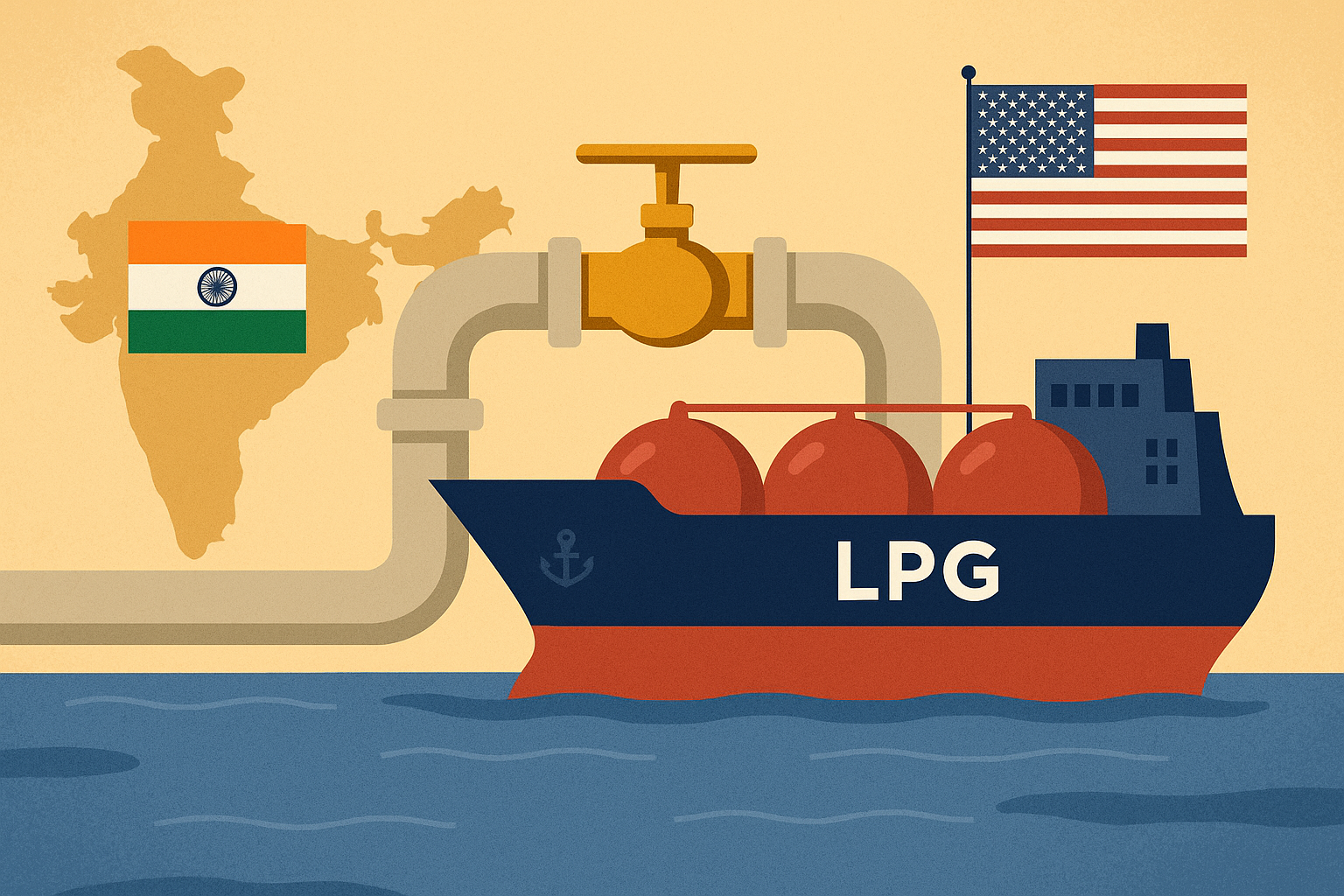India Signs First LPG Term Deal with the US
Business Standard

1. Introduction and Context
This article analyses a major shift in India’s energy strategy: the country has signed its first-ever long-term LPG (Liquefied Petroleum Gas) supply agreement with the United States, securing 2.2 million tonnes annually for 2024–25.
The deal comes at a time of evolving global energy markets, U.S.–India trade negotiations, and uncertainty created by geopolitical tensions such as the Russia–Ukraine war and OPEC+ production decisions.
It carries significant implications for India’s energy security, strategic partnerships, LPG demand management, and broader economic–geopolitical stability.
2. Key Arguments Presented
a. India signs its first long-term LPG deal with the U.S.
- Public Oil Marketing Companies (IOCL, BPCL, HPCL) finalize a 12-year contract.
- Ensures supply of ~2.2 million tonnes annually.
- Marks diversification away from Middle Eastern dependence.
b. India’s rising LPG consumption demands diversification
- India is the world’s 2nd-largest LPG importer.
- Demand growth driven by Ujjwala scheme, rural adoption, and population growth.
- The U.S. offers competitive, low-cost LPG exports.
c. The agreement aligns with India’s geopolitical and energy strategy
- Reduces vulnerability to disruptions in Russia and OPEC+ supply.
- Enhances India’s negotiating power in global energy markets.
- Strengthens India–U.S. strategic and trade ties.
d. Fitch: No major impact on Indian OMC margins
- New U.S. sanctions on Russian oil unlikely to hurt Indian oil companies.
- Indian OMCs have already diversified procurement since 2022.
3. Author’s Stance
The stance is positive and pragmatic.
The article presents the deal as a smart move for strengthening energy security and deepening India–U.S. ties.
Tone: Supportive, strategic, and future-oriented.
4. Biases and Limitations
Bias
- Leans toward a government-friendly narrative showcasing the deal as a success.
- Little discussion of potential long-term risks.
Limitations
- No analysis of pricing formulas or cost volatility.
- Ignores environmental implications of continued LPG dependency.
- Sustainability vis-à-vis India’s green energy transition is not examined.
5. Pros and Cons of the Deal
Pros
- Stronger energy security with assured long-term supply.
- Reduced dependence on Middle East producers.
- Strategic advantage in global geopolitics.
- Potential for more stable LPG pricing for consumers.
- No significant margin risk due to Russian sanctions.
Cons
- Prolongs dependence on fossil fuels.
- Exposure to U.S. price cycles and market volatility.
- May require expansion of ports, storage, and logistics.
- Risks increased fiscal burden if subsidies rise.
6. Policy Implications
a. Energy Security (GS III)
- Need for greater storage, distribution networks, and possibly strategic LPG reserves.
- Must align LPG imports with long-term energy transition goals.
b. International Relations (GS II)
- Strengthens bilateral ties with the U.S.
- Could influence ongoing India–U.S. BTA discussions.
c. Welfare Programs (GS II)
- Supports Ujjwala and household clean cooking goals through stable supply.
- But subsidy sustainability must be managed.
d. Economic Stability
- Predictable pricing supports inflation control.
- Reduces risk from volatile Middle East supply chains.
7. Real-World Impact
Short-Term
- Improved LPG availability.
- Stable cylinder pricing.
- Strengthened India–U.S. strategic engagement.
Medium-Term
- Reduced vulnerability to geopolitical shocks.
- Better bargaining position in global LPG procurement.
Long-Term
- Possible tension between fossil fuel reliance and renewable energy targets.
- Expanded scope for global energy diplomacy.
8. Alignment with UPSC GS Papers
GS Paper I:
Energy geography, global trade flows.
GS Paper II:
India–U.S. relations, international agreements, governance and welfare.
GS Paper III:
Energy security, LPG penetration, infrastructure, economic implications of sanctions.
GS Paper IV:
Duty of the state to ensure essential services and welfare.
9. Conclusion and Future Perspectives
The article frames the India–U.S. LPG agreement as a major development in India’s energy security plan and geopolitical strategy. It strengthens supply stability, reduces dependence on traditional suppliers, and deepens ties with the U.S.
However, moving ahead, India must:
- Ensure price stability
- Expand storage and logistics
- Balance LPG imports with renewable energy goals
- Integrate the deal into long-term strategic planning
The agreement is strategically positive today, but careful future planning is essential to align it with India’s broader energy transition and economic priorities.
